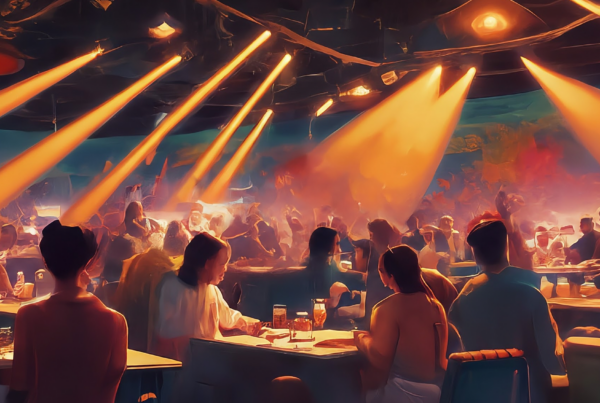In the ever-evolving world of hospitality and entertainment, creating a memorable dining experience goes beyond just serving exquisite dishes. As we step into 2025, the integration of Innovative Strategies for Restaurant Video Programming is becoming a game-changer for businesses aiming to captivate their audience and enhance customer engagement. Imagine transforming your restaurant’s ambiance with dynamic video content that not only entertains but also informs and connects with your patrons on a deeper level.
With the rise of digital media, restaurants are leveraging video programming to create immersive environments that resonate with their clientele. This not only helps in setting the mood but also in reinforcing the restaurant’s brand identity. Whether it’s showcasing a behind-the-scenes look at the culinary process or featuring customer testimonials, video content is a powerful tool for storytelling and building brand loyalty.
For businesses in the hospitality industry, such as casinos, bars, and multi-location restaurants, adopting these innovative strategies can mean the difference between standing out or blending in with the competition. By implementing cutting-edge video programming solutions, you can offer a centralized entertainment experience that is both engaging and consistent across all locations. This approach not only elevates the customer experience but also enhances operational efficiency.
In this blog post, we will explore the transformative power of video programming and provide insights into how you can harness its potential to revolutionize your restaurant’s atmosphere. From understanding the latest trends to practical tips on implementation, we’ll guide you through the essential steps to stay ahead in the competitive landscape of 2025. Let’s dive into the first key strategy that will set the stage for a new era of dining experiences.
Interactive Video Content: Engaging Your Audience in Real-Time
In the dynamic world of restaurant marketing, interactive video content stands out as a powerful tool to engage customers in real-time. As we look towards 2025, leveraging interactive videos can transform the way restaurants connect with their audience, offering a more personalized and engaging experience. By incorporating elements such as live streaming, polls, and clickable features, restaurants can create a two-way communication channel that not only entertains but also gathers valuable customer insights.
Interactive video content allows restaurants to showcase their unique offerings while actively involving their audience in the experience. Whether it’s a live cooking demonstration or a virtual tour of the restaurant, these interactive elements can significantly enhance customer engagement and build a loyal community around your brand. Let’s explore some innovative strategies for implementing interactive video content in your restaurant’s marketing plan.
Live Streaming Events: Bringing the Restaurant Experience Home
Live streaming is a game-changer for restaurants aiming to offer an immersive experience to their customers. By broadcasting events like cooking classes, wine tastings, or live music performances, restaurants can reach a wider audience beyond their physical location. This not only helps in promoting the restaurant’s ambiance and offerings but also creates a sense of exclusivity and excitement among viewers.
To maximize the impact of live streaming, it’s essential to promote the event in advance through social media and email newsletters. Engaging with viewers during the stream by answering questions or offering special discounts can further enhance the interactive experience. After the event, repurpose the content for future marketing efforts, ensuring it continues to drive engagement long after the live stream ends.
Interactive Menus and Polls: Letting Customers Have a Say
Interactive menus and polls are another innovative way to engage customers through video content. By incorporating clickable elements in videos, restaurants can allow viewers to explore menu items, learn about ingredients, or even vote for their favorite dishes. This not only makes the viewing experience more engaging but also provides valuable feedback that can inform menu development and marketing strategies.
For example, a video showcasing new menu items could include clickable sections that provide detailed descriptions or customer reviews. Polls can be used to gather opinions on potential new dishes or special events, giving customers a sense of involvement in the restaurant’s offerings. By making the audience an active participant, restaurants can foster a deeper connection and loyalty among their patrons.
Innovative Video Programming Techniques for 2025
As we approach 2025, the landscape of restaurant video programming is rapidly evolving, offering new opportunities for businesses to engage and captivate their audiences. Embracing these Innovative Strategies for Restaurant Video Programming can transform your establishment’s ambiance and customer experience. By leveraging cutting-edge techniques, restaurants can create compelling narratives that resonate with patrons, ultimately enhancing brand loyalty and customer satisfaction.
In this section, we will explore some of the most promising video programming techniques for 2025, focusing on platform-specific optimization and creative storytelling. These strategies not only help in crafting engaging content but also ensure that your videos reach the right audience effectively. Let’s delve into these innovative approaches that can set your restaurant apart in the competitive hospitality industry.
Platform-Specific Optimization: Tailoring Content for Maximum Impact
One of the key trends in video programming for 2025 is the emphasis on platform-specific optimization. Each social media platform has its own unique characteristics and audience preferences, which means that a one-size-fits-all approach is no longer effective. By tailoring your video content to suit the nuances of each platform, you can significantly enhance engagement and reach.
For instance, short, snappy videos with quick cuts and trending music perform exceptionally well on platforms like TikTok and Instagram Reels. Meanwhile, YouTube audiences prefer more detailed storytelling and higher production quality. By understanding these differences and optimizing your content accordingly, you can maximize your video’s impact and connect with a broader audience.
To implement this strategy, start by analyzing the demographics and preferences of your target audience on each platform. Use this data to craft content that aligns with their interests and viewing habits. Additionally, consider using platform-specific features such as interactive polls on Instagram Stories or live streaming on Facebook to further engage your audience.
Creative Storytelling: Crafting Compelling Narratives
Creative storytelling remains a cornerstone of effective video programming. In 2025, restaurants can leverage this technique to create immersive narratives that captivate and inspire their audience. By focusing on authentic storytelling, you can forge a deeper connection with your patrons and enhance your brand’s identity.
Consider showcasing the unique aspects of your restaurant through behind-the-scenes videos, chef interviews, or customer testimonials. These narratives not only highlight your offerings but also humanize your brand, making it more relatable and memorable. For example, a video series featuring your chef’s journey or the story behind your signature dish can create an emotional connection with viewers.
To effectively utilize creative storytelling, start by identifying the core values and messages you want to convey. Develop a content calendar that outlines the themes and stories you wish to explore. Collaborate with your team to brainstorm ideas and ensure that each video aligns with your brand’s vision and goals.
Step-by-Step Guide: Implementing New Video Techniques
To successfully implement these innovative video programming techniques, follow this step-by-step guide:
- Research and Analyze: Begin by researching the latest trends in video programming and analyzing your competitors’ strategies. Identify gaps and opportunities to differentiate your content.
- Define Your Goals: Clearly outline your objectives for each video campaign, whether it’s increasing brand awareness, driving foot traffic, or promoting a new menu item.
- Plan and Produce: Develop a detailed production plan that includes storyboarding, scripting, and scheduling. Ensure that your videos are visually appealing and align with your brand’s aesthetics.
- Optimize and Distribute: Tailor your videos for each platform by optimizing formats, lengths, and interactive elements. Use targeted distribution strategies to reach your desired audience effectively.
- Measure and Adjust: Continuously monitor the performance of your videos using analytics tools. Gather insights on viewer engagement and adjust your strategies to improve future campaigns.
By following these steps, restaurants can harness the power of innovative video programming techniques to enhance their customer experience and stand out in the competitive landscape of 2025.
Measuring the Success of Video Strategies
In the rapidly evolving landscape of restaurant video programming, understanding how to measure the success of your video strategies is crucial. As we move into 2025, the ability to evaluate the effectiveness of your video content will determine your restaurant’s ability to engage customers and enhance their experience. By focusing on key performance indicators (KPIs), you can gain valuable insights into how your videos are performing and make data-driven decisions to optimize your strategy.
To ensure your video strategies are successful, it’s essential to track a range of metrics that provide a comprehensive view of performance. These metrics not only help in understanding viewer engagement but also in identifying areas for improvement. Let’s delve into some of the most important KPIs that can guide your restaurant’s video strategy to success.
Key Performance Indicators for Video Success
Tracking the right KPIs can provide a clear picture of how your video content is resonating with your audience. Here are some critical metrics to consider:
- View Count: The number of times your video has been watched. This metric gives a basic indication of reach and popularity.
- Engagement Rate: Measures how actively viewers are interacting with your video through likes, comments, and shares. High engagement suggests that your content is compelling and resonates with your audience.
- Completion Rate: The percentage of viewers who watch your video from start to finish. A high completion rate indicates that your content is engaging enough to hold viewers’ attention.
- Click-Through Rate (CTR): The ratio of viewers who click on a call-to-action (CTA) in your video. This metric is essential for understanding how effective your video is in driving desired actions.
- Conversion Rate: The percentage of viewers who take a specific action after watching your video, such as making a reservation or signing up for a newsletter. This KPI directly correlates with your video’s impact on business goals.
Tools and Techniques for Measuring Video Performance
To effectively measure these KPIs, utilizing the right tools and techniques is essential. Here are some recommended approaches:
- Analytics Platforms: Use platforms like YouTube Analytics, Facebook Insights, and Instagram Insights to track views, engagement, and other key metrics. These tools provide detailed reports and visualizations to help you understand performance trends.
- Google Analytics: Integrate your video content with Google Analytics to track how videos drive traffic to your website and influence conversions. This integration allows you to attribute specific outcomes to your video efforts.
- UTM Parameters: Implement UTM tracking codes in your video links to monitor how viewers interact with your content across different platforms. This technique helps in identifying which videos are most effective in driving traffic and conversions.
Adjusting Strategies Based on Insights
Once you have gathered data from these KPIs and tools, the next step is to analyze the insights and adjust your strategies accordingly. Here are some tips for using data to refine your video strategy:
- Identify Trends: Look for patterns in your data to understand what types of content resonate most with your audience. Use this information to create more of what works and less of what doesn’t.
- Test and Iterate: Experiment with different video formats, lengths, and styles to see what yields the best results. Continuous testing and iteration are key to optimizing your video strategy.
- Focus on High-Impact Areas: Allocate resources to the videos and platforms that drive the most engagement and conversions. Prioritizing high-impact areas ensures that your efforts are aligned with your business goals.
By effectively measuring the success of your video strategies, you can ensure that your restaurant’s video programming efforts are not only engaging but also driving tangible results. This data-driven approach will help you stay ahead in the competitive hospitality industry of 2025.
Revolutionize Your Restaurant with Cutting-Edge Video Strategies
As the dining landscape transforms in 2025, embracing Innovative Strategies for Restaurant Video Programming is no longer optional—it’s essential. These strategies redefine how restaurants engage with their patrons, offering a dynamic blend of entertainment and information that elevates the dining experience. By integrating interactive video content, live streaming, and creative storytelling, your restaurant can create an immersive atmosphere that captivates and retains customers.
Reflecting on the insights shared throughout this blog post, it’s clear that video programming is a powerful tool for brand differentiation and customer engagement. From platform-specific optimization to measuring KPIs, each strategy provides a pathway to enhance your restaurant’s ambiance and operational efficiency. Whether you’re a single-location eatery or a multi-location chain, these video techniques can help you stand out in the competitive hospitality market.
Key Takeaways for Implementing Video Strategies
- Interactive Video Content: Engage your audience with live streaming events and interactive menus that invite real-time participation.
- Platform-Specific Optimization: Tailor your content to align with the unique characteristics of each social media platform for maximum impact.
- Creative Storytelling: Craft narratives that resonate with your audience, showcasing the unique aspects of your restaurant.
- Data-Driven Adjustments: Use analytics to refine your strategies, focusing on high-impact areas that drive engagement and conversions.
As you consider implementing these strategies, ask yourself: How can video programming transform your restaurant’s customer experience? By taking action on these insights, you can not only enhance your restaurant’s ambiance but also strengthen your brand’s connection with its audience. For more insights and to explore how DLM Media can support your video programming needs, visit our website.
Join the conversation! Share your thoughts and experiences with restaurant video programming in the comments below. Your insights could inspire others and contribute to a thriving community of forward-thinking restaurateurs.





